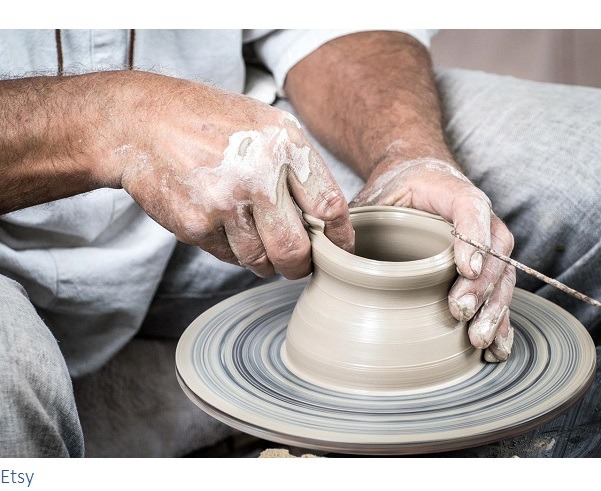Using handmade accessories such as jewelry or bags are the easiest way to add charm to your everyday life. They are essentially small pieces of art you can carry around with you, and their collection and usage over time can more powerfully impact your signature style to be more unique: since industrialization has diminished the impressiveness of everyday items and mass production means that large amounts of similar items can often be possessed by members of the same community, artisan designers are forced now to craft unique, one-of-a-kind designs. It is for these reasons that handmade items have increased so much in popularity, as globalization and modernization are calling for a renaissance in the market of handmade goods.
While locality has always been a concern of most patrons of handmade items, globalization as forced a large majority of sales to be conducted online. The number of small businesses selling handmade goods has skyrocketed, making it easier than ever to enjoy the work of makers all across the planet. So where, exactly, should you look if you’re in the market for these goods?
There are, of course, many answers to this question. However, every answer can be categorized into two groups depending on whether they are independently-run such as https://shoprsd.vip/, or if a large portion of their traffic comes from being on a selling platform specifically for handmade goods. The former category is beyond the scope of this article, but conscious consumers should still feel encouraged to explore businesses’ history and practices to make smart decisions about their purchases. This article will, however, compare and contrast the different online platforms for selling handmade goods, as these larger companies’ history and practices trickle down to affect each business on their platform, so they are therefore important as well.
Handmade at Amazon
Many consumers know Amazon as the place for almost every good, despite the company starting off as a bookstore. Handmade at Amazon is its flagship program which has been around for a couple of years for artisan sellers to get in on the fun as well. Before sellers can list their products, they must go through a lengthy approval process to ensure that the seller is really the maker of their products and that they posses all of the necessary copyrights. Therefore, buying items through Handmade at Amazon, consumers can be confident that they are truly supporting real artisans. However, the approval process also requires these artisans to have their business grown to a certain capability before they may start selling on Amazon, so the businesses you’ll find on Amazon are already large—so, if your goal is to shop small, you may want to look elsewhere.
Etsy
To not mention Etsy on an article detailing handmade business e-commerce platforms would be remiss; Etsy is perhaps the go-to platform for handmade goods since its founding in 2005 (that’s the same year YouTube was launched!). And it has recently seen a boom in users since the COVID-19 pandemic: according to this Statista report, the number of active sellers on Etsy slowly grew from just over a thousand actice sellers in 2013 to just over 2,000 in 2018, to seeing a small spike in 2019 to almost 2,700. This number then increased by 1.62 times in 2020, during the COVID-19 pandemic and then again increased, even more so this time, by 1.72 times in the pandemic’s second year. As of December of 2021 Etsy now boasts over 7,500 active sellers.
Compare that to the number of active buyers on Etsy in 2021—96.34 million—and therein lies one of the main reasons sellers are attracted to Etsy: it has a large customer base with regular traffic, meaning sellers can spend less time and resources on advertising. Etsy shops have become surprisingly easy to set up, but this has come at the cost of the occurrence of increasing shops which sell wares that are less than handmade. Consumers can still be confident they are supporting independent designers, but should know to look for whether items were produced with production partners if that is a factor which would influence their decision.
Storenvy
Storenvy is a relatively less-known marketplace similar to Etsy which allows small creators to sell their products to a larger customer base. Unlike Etsy, it does not charge any listing fees and no subscription fees on top of that to use, making it more accessible for beginner sellers. They have recently started experimenting with a “nominal” transaction fee, but this incurs cost to sellers, not to customers.
Storenvy’s relative size in this market informs its reliability, and many of its users often complain about the website crashes and glitches. They also do not handle transactions themselves and instead use integrations of PayPal and Stripe, so website glitches may cause problems with purchases.
Society6
Society6 works a bit differently from the marketplaces explored up until now: instead of makers uploading photos and writing descriptions for listings for physical products, Society6 allows artists to upload designs for print-on-demand products (such as cell phone cases, throw pillows, tapestries, posters, and more) which Society6 then handles the production of. Therefore, Society6 isn’t necessarily for handmade items, but moreso hand-designed products, so this is important to remember when shopping on this platform. Additionally, since Society6 handles the production and shipping of each product sold, independent sellers get a significantly lower portion of the proceeds from each sale compared to other marketplaces.
Indiecart
Also known as HyenaCart, Indiecart is often seen as an alternative to Etsy, differing in that it does not allow the sale of vintage items or craft supplies. Their pricing for sellers is also different: they charge a one-time setup fee, and then a subscription fee of $7.50 USD each month after that. Indiecart is perhaps the least well-known platform on this list, but that makes it perfect for finding truly unique items. They also allow sellers to open independent stores or partner with other stores to increase their exposure.

